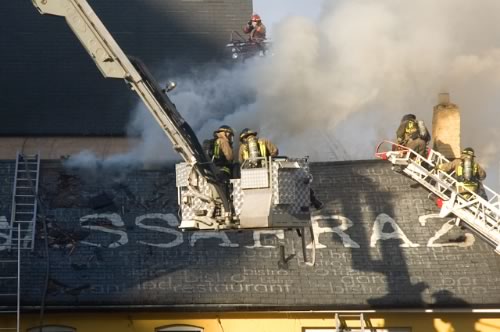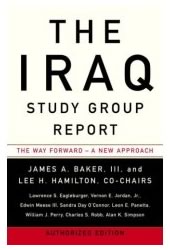
Torontoist has posted Marc Lostracco’s photos of Sassafraz, the day after the fire, and you can find more photos on Flickr.
(For more on Sassafraz, see today’s earlier entry titled Sassafraz and Schadenfreude.)

Torontoist has posted Marc Lostracco’s photos of Sassafraz, the day after the fire, and you can find more photos on Flickr.
(For more on Sassafraz, see today’s earlier entry titled Sassafraz and Schadenfreude.)
Texas Monthly, “The National Magazine of Texas”, runs its annual “Bum Steers Awards” every January. This coming January, U.S. Vice President Dick Cheney gets a place both in the awards and on the cover:

The fine print on the cover reads:
* Yes, this is a photo illustration. If we don’t say so, Dick Cheney will shoot us in the face.

Photo by David Topping. Click to see the original on its page.
For those of you not familiar with Accordion City, Sassafraz was a restaurant in the tony boutique area of town known as Yorkville. The place had a reputation for so-so food at ridiculous prices (I’ve had brunch and lunch there, and yeah, you can get much better for the money), but that’s not why one went there. It was a big celebrity hangout. Whenever a big movie star was in town on a movie shoot or publicity tour — and that’s fairly often — they often ended up at Sassafraz.
I use the past tense because Sassafraz burned down yesterday afternoon in a five-alarm fire that brought over 40 fire vehicles and called for 135 firefighters. Here are some major news outlet stories on the fire:
And here’s what the online locals have had to say:
My cousin, Malou, is in the restaurant business. She worked in Manila for years, then in New York, and as of March, she’s been working here in Accordion City — at Sassafraz. Naturally, the first thing I did was to call her mobile phone and see if she was all right.
“C’mon,” I said to no one in particular while the phone rang, “pick up…”
“Hello?”
“Hey, Malou, it’s Joey — just checking to see if you’re all right.”
“All right? Oh yeah — the restaurant. It’s okay, I took a sick day today.”
“That’s got to be the best timing ever,” I said, “I’ve already told Mom that Sassafraz is on fire, so expect a call from her any time now. And hey, if you need anything, you know that you can call any one of us.” (The closest immediate family she’s got is in California; the rest are in Manila.) “I’ll see you at the Christmas party if not sooner.”
Whew.
I find it disappointing — but not surprising — at the various online comments expressing near-glee at the news that Sassafraz burned down (one commenter on BlogTO was hoping that the Drake Hotel was next). While I believe that celebrities are generally over-worshipped and overrated, I don’t see see much reason to jump for joy at the loss of a local business, especially one that played a key part in the Toronto International Film Festival, which in turn feeds one of the city’s most high-profile industries, the film industry. Consider also the people who worked at Sassafraz. Thankfully, none of them were injured, but consider that they’re now without a source of income, and we’re deep into the holiday season.
If local indie-hipster hangout 56 Kensington (a charming hole-in-the-wall in the city’s most boho neighbourhood) had burned down, there’d have been a benefit concert with the Barcelona Pavilion as the headline act, and there would’ve been a general call among the local underemployed arts graderati to save an important cultural landmark.
In my opinion, there’s room and need for local institutions of all sorts in this city — from hipster dive bars to Zagat top-rated restos. The sooner we get our collective heads out of our collective asses and recognize that, the better this city will be.

For you news junkies, policy nerds, political bloggers and people wondering what the Iraq Study Group’s recommendations for how to fix the Mess O’ Potamia are, the Iraq Study Group Report is now available. 142 pages, 79 recommendations, the difference between Sunnis and Shi’ites explained (and some people in Washington need to study up on that), and one president who’s likely to ignore it if it differs from the “things are going well” tack.
An excerpt:
Current U.S. policy is not working, as the level of violence in
Iraq is rising and the government is not advancing national reconciliation. Making no changes in policy would simply delay
the day of reckoning at a high cost. Nearly 100 Americans are
dying every month. The United States is spending $2 billion a
week. Our ability to respond to other international crises is
constrained. A majority of the American people are soured on
the war. This level of expense is not sustainable over an extended period, especially when progress is not being made.
The longer the United States remains in Iraq without progress,
the more resentment will grow among Iraqis who believe they
are subjects of a repressive American occupation. As one U.S.
official said to us, “Our leaving would make it worse….The
current approach without modification will not make it better.”
Here’s how you can get your paws on it:
Another excerpt:
The United States has made a massive commitment to the future of Iraq in both blood and treasure. As of December 2006,
nearly 2,900 Americans have lost their lives serving in Iraq. Another 21,000 Americans have been wounded, many severely.
To date, the United States has spent roughly $400 billion
on the Iraq War, and costs are running about $8 billion per
month. In addition, the United States must expect significant
“tail costs” to come. Caring for veterans and replacing lost
equipment will run into the hundreds of billions of dollars. Estimates run as high as $2 trillion for the final cost of the U.S. in-
volvement in Iraq.
Despite a massive effort, stability in Iraq remains elusive
and the situation is deteriorating. The Iraqi government cannot
now govern, sustain, and defend itself without the support of
the United States. Iraqis have not been convinced that they
must take responsibility for their own future. Iraq’s neighbors
and much of the international community have not been persuaded to play an active and constructive role in supporting
Iraq. The ability of the United States to shape outcomes is diminishing. Time is running out.

That’s the news according to CNET and the JamesAndKati.com site. My deepest condolences to the Kims and their family and friends.
Their families have spent a lot of money on the rescue effort, and there’s the matter of a funeral and helping Kati and the kids back on their feet. If you’ve got a little money (and some Christmas spirit) to spare, please consider making a donation at the JamesAndKati.com site.

If you’ve been following the story about the Kims (which I mentioned in the previous entry), there’s a site set up by their friends and family: JamesAndKati.com. It’s got news and updates, as well as a guestbook where you can leave some best wishes and words of support.
One story that will stick with me forever is Jack London’s short story of winter survival, To Build a Fire. It seemed as if it was on the curriculum of every Canadian grade school when I was a young teenager, and I’m sure everyone who’s taken a winter survival course was told to read it as a cautionary tale.

Later, at Crazy Go Nuts University, at the start of COMM 101 — “Intro to Business” — one of the first group exercises we did in the class was to explain how we’d handle a hypothetical situation. The purpose of the exercise was to demonstrate group dynamics and decision-making, and it went like this: We were in a small plane that crashed in the desert somewhere in the southwestern U.S.. The pilot is dead, and we have limited supplies: some water, a knife, a little food, salt tables, a large white parachute and a few other items. There’s nothing but flats as far as the eye can see. What do we do?
I argued for staying with plane, taking shelter, stretching our water supply and making ourselves as findable as possible. Someone else in our group, who’d just seen the movie Alive a few days prior, argued that we’d die if we stayed there. She said that the only way to survive was to make our way towards civilization or a road.
Although the purpose of the exercise was to explain the 90/10 dynamic of groups (generally, a group is 10% alpha dogs — me and the Alive fan — and 90% pack) and other aspects of group decision-making, we were given the correct answer, and that was to stay put and use the parachute as both shielding against the sun and a way of being spotted from the air. Even after the explanation, the Alive fan was unconvinced. “But…Alive…” she said.
One of these days, I’m going to have to rent that movie.

Kati Kim, after being rescued after nine days of being trapped in a car on a mountain in Oregon.
I bring up both these stories because the story of James Kim and his family reminded me of them. If you’re a follower of the tech news or live on the American west coast, you’ve probably heard this news. James Kim, an editor for CNET and familiar face for G4/TechTV viewers, his wife Kati and daughters Penelope and Sabine went missing days ago on a road trip to the Pacific Northwest. Their story, in a nutshell: they took a mountain road that they thought would be a shortcut and ended up getting trapped in very deep snow. They ran the engine to power the heater until it ran out of gas, and then burned the tires. Finally, James set off to get help. Kati and the girls were found alive nine days later and are in good condition. The search for James continues.
I’m very happy that Kati and the kids have been found, and my heart goes out to them. I hope they find James alive and well, and soon.
Back in the fall of 1986 and the winter of 1987, I made the drive between Toronto and Montreal an average of once every three weeks to party with my sister and her friends at McGill (those stories should be blogged someday). The driving, while nowhere nearly as treacherous as the mountain routes taken by the Kim family, could still be pretty bad at times; sometimes, the snowfall and winds would be so bad that we had to pull over and wait. I never let the gas gauge drop significantly below half-full, and I always had an extra sweater, a small shovel, a road safety kit and some Wunderbars handy. The longest I ever had to sit still in a storm was about five hours, after which I had to dig out the car.
As I mentioned earlier, the Kims’ problem is orders of magnitude worse than anything I’ve faced. Highway 401 is not the same thing as the mountain pass they took. Even if I’d run out of gas during a blizzard on the 401, help is never far away from that very well-travelled route.
Here’s a question for the winter survival experts: if in the situation like the Kims (let’s ignore the prevention aspect for the moment), is it better to stay put, or go for help?